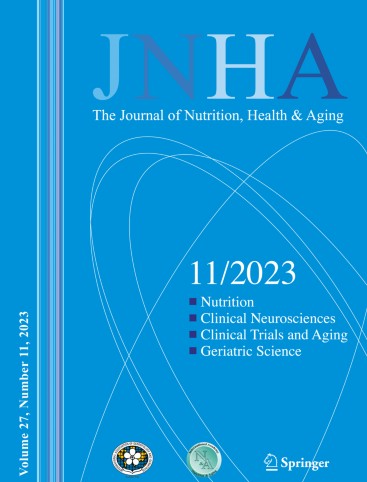Biomarkers of cellular senescence predict risk of mild cognitive impairment: Results from the lifestyle interventions for elders (LIFE) study
IF 4
3区 医学
Q1 GERIATRICS & GERONTOLOGY
引用次数: 0
Abstract
Objectives
Cellular senescence, characterized by a marked and multifactorial senescence-associated secretory phenotype (SASP), is a potential unifying mechanism of aging and chronic disease. Most studies of the SASP have focused on frailty and other functional outcomes. Senescent cells have been detected in the brains of patients with Alzheimer’s disease, but few studies have examined associations between plasma SASP markers and cognition. The objective of this study was to examine the cross-sectional and longitudinal associations between plasma SASP markers and mild cognitive impairment among older adults at high risk of mobility disability.
Design
The Lifestyle Interventions for Elders (LIFE) study was a randomized controlled trial of a group-based physical activity program compared to a “successful aging” health education program to assess effects on major mobility disability that was conducted from February 2010 to December 2013.
Setting
Recruitment occurred at eight centers in the United States.
Participants
We included 1,373 participants enrolled in the study with baseline measures of 27 biomarkers of cellular senescence and adjudication of mild cognitive impairment (MCI) and dementia at baseline and 24-month follow-up. At baseline, participants were aged 70–80, sedentary, and at high risk of mobility disability.
Measurements
A neuropsychological assessment was administered at baseline and 24 months post-randomization. At both timepoints, a clinical adjudication committee determined whether individuals had a diagnosis of cognitively normal, MCI, or dementia; individuals with dementia at baseline were excluded. The concentrations of 26 of the 27 plasma proteins identified as components of the SASP were measured with commercially available Luminex xMAP multiplex magnetic bead-based immunoassays analyzed on the MAGPIX System while 1 protein (Activin A) was measured using an enzyme-linked immunosorbent assay.
Results
Logistic regression models were used to examine the associations of each senescence biomarker, in quartiles, with baseline or incident MCI. Models stratified by clinical site and adjusted for intervention assignment, age, gender, race, and education. Among 1,373 participants, 117 (8.5%) were diagnosed with MCI at baseline. Increasing quartiles of myeloperoxidase (MPO) was associated with higher odds of MCI compared to quartile 1 (Q2: OR = 1.34, 95% CI: 0.74–2.45; Q3: OR = 1.43, 95% CI: 0.80–2.59; Q4: OR = 1.79, 95% CI: 1.02–3.22). Additionally, matrix metalloproteinase 1 (MMP1) quartiles 2–4 had lower odds of MCI compared to quartile 1 (Q2: OR = 0.61, 95% CI: 0.35–1.02; Q3: OR = 0.58, 95% CI: 0.33−0.98; Q4: OR = 0.64, 95% CI: 0.37–1.08). Of the 1,256 cognitively unimpaired participants at baseline, 141 (11.2%) were diagnosed with incident MCI or dementia at the 24-month follow-up. Compared to quartile 1, increasing baseline quartiles of MPO (Q2: OR = 1.10, 95% CI: 0.63–1.92; Q3: OR = 1.36, 95% CI: 0.80–2.33; Q4: OR = 1.92, 95% CI: 1.16–3.25) and matrix metalloproteinase 7 (MMP7, Q2: OR = 0.88, 95% CI: 0.47–1.62; Q3: OR = 1.46, 95% CI: 0.85–2.55; Q4: OR = 2.14, 95% CI: 1.28–3.65) were associated with increased odds of MCI or dementia at 24 months.
Conclusions
Among older adults at high risk of mobility disability, high plasma MPO was cross-sectionally and, along with MMP7, longitudinally associated with increased odds of MCI and dementia. In contrast, high MMP1 was cross-sectionally associated with reduced odds of MCI.
细胞衰老的生物标志物预测轻度认知障碍的风险:来自老年人生活方式干预(LIFE)研究的结果
细胞衰老具有显著的多因子衰老相关分泌表型(SASP),是衰老和慢性疾病的潜在统一机制。大多数关于SASP的研究都集中在虚弱和其他功能结果上。在阿尔茨海默病患者的大脑中已经检测到衰老细胞,但很少有研究检测血浆SASP标记物与认知之间的关系。本研究的目的是检查血浆SASP标志物与行动障碍高风险老年人轻度认知障碍之间的横断面和纵向关联。老年人生活方式干预(LIFE)研究是一项随机对照试验,将基于群体的体育活动计划与“成功的老龄化”健康教育计划进行比较,以评估对主要行动障碍的影响,该研究于2010年2月至2013年12月进行。招募在美国的8个中心进行。参与者我们纳入了1373名参与者,他们在基线和24个月的随访中测量了27种细胞衰老生物标志物和轻度认知障碍(MCI)和痴呆的判定。在基线时,参与者年龄在70-80岁之间,久坐不动,行动障碍的风险很高。测量:在基线和随机化后24个月进行神经心理学评估。在这两个时间点,临床裁决委员会确定个体是否被诊断为认知正常、轻度认知障碍或痴呆;基线时患有痴呆的个体被排除在外。27种血浆蛋白中的26种被鉴定为SASP的组成成分,使用市售的Luminex xMAP多路磁珠免疫分析法在MAGPIX系统上进行检测,而1种蛋白(激活素A)使用酶联免疫吸附法进行检测。结果使用逻辑回归模型以四分位数为单位检查每种衰老生物标志物与基线或事件MCI的关联。模型按临床地点分层,并根据干预分配、年龄、性别、种族和教育程度进行调整。在1,373名参与者中,117名(8.5%)在基线时被诊断为轻度认知障碍。与四分位数1相比,髓过氧化物酶(MPO)增加的四分位数与MCI的几率较高相关(Q2: OR = 1.34, 95% CI: 0.74-2.45;Q3: or = 1.43, 95% ci: 0.80-2.59;Q4: or = 1.79, 95% ci: 1.02-3.22)。此外,基质金属蛋白酶1 (MMP1)四分位数2-4与四分位数1相比,MCI的发生率较低(Q2: OR = 0.61, 95% CI: 0.35-1.02;Q3: or = 0.58, 95% ci: 0.33 ~ 0.98;Q4: or = 0.64, 95% ci: 0.37-1.08)。在1256名基线时认知功能未受损的参与者中,141名(11.2%)在24个月的随访中被诊断为MCI或痴呆。与四分位数1相比,MPO基线四分位数增加(Q2: OR = 1.10, 95% CI: 0.63-1.92;Q3: or = 1.36, 95% ci: 0.80-2.33;Q4: OR = 1.92, 95% CI: 1.16-3.25)和基质金属蛋白酶7 (MMP7, Q2: OR = 0.88, 95% CI: 0.47-1.62;Q3: or = 1.46, 95% ci: 0.85-2.55;Q4: OR = 2.14, 95% CI: 1.28-3.65)与24个月时MCI或痴呆的发生率增加相关。结论:在行动障碍高风险的老年人中,高血浆MPO与MMP7呈横断面相关性,并与MCI和痴呆的发生率增加呈纵向相关性。相反,高MMP1横断面与MCI发生率降低相关。
本文章由计算机程序翻译,如有差异,请以英文原文为准。
求助全文
约1分钟内获得全文
求助全文
来源期刊
CiteScore
7.80
自引率
3.40%
发文量
136
审稿时长
4-8 weeks
期刊介绍:
There is increasing scientific and clinical interest in the interactions of nutrition and health as part of the aging process. This interest is due to the important role that nutrition plays throughout the life span. This role affects the growth and development of the body during childhood, affects the risk of acute and chronic diseases, the maintenance of physiological processes and the biological process of aging. A major aim of "The Journal of Nutrition, Health & Aging" is to contribute to the improvement of knowledge regarding the relationships between nutrition and the aging process from birth to old age.

 求助内容:
求助内容: 应助结果提醒方式:
应助结果提醒方式:


